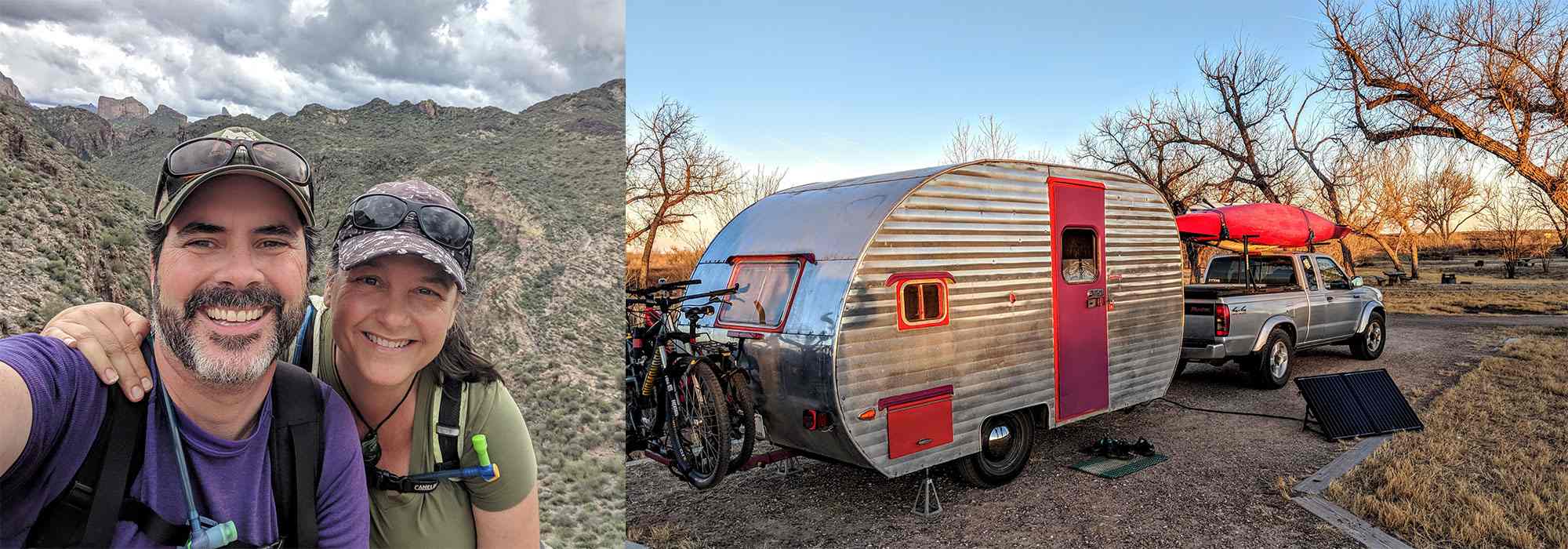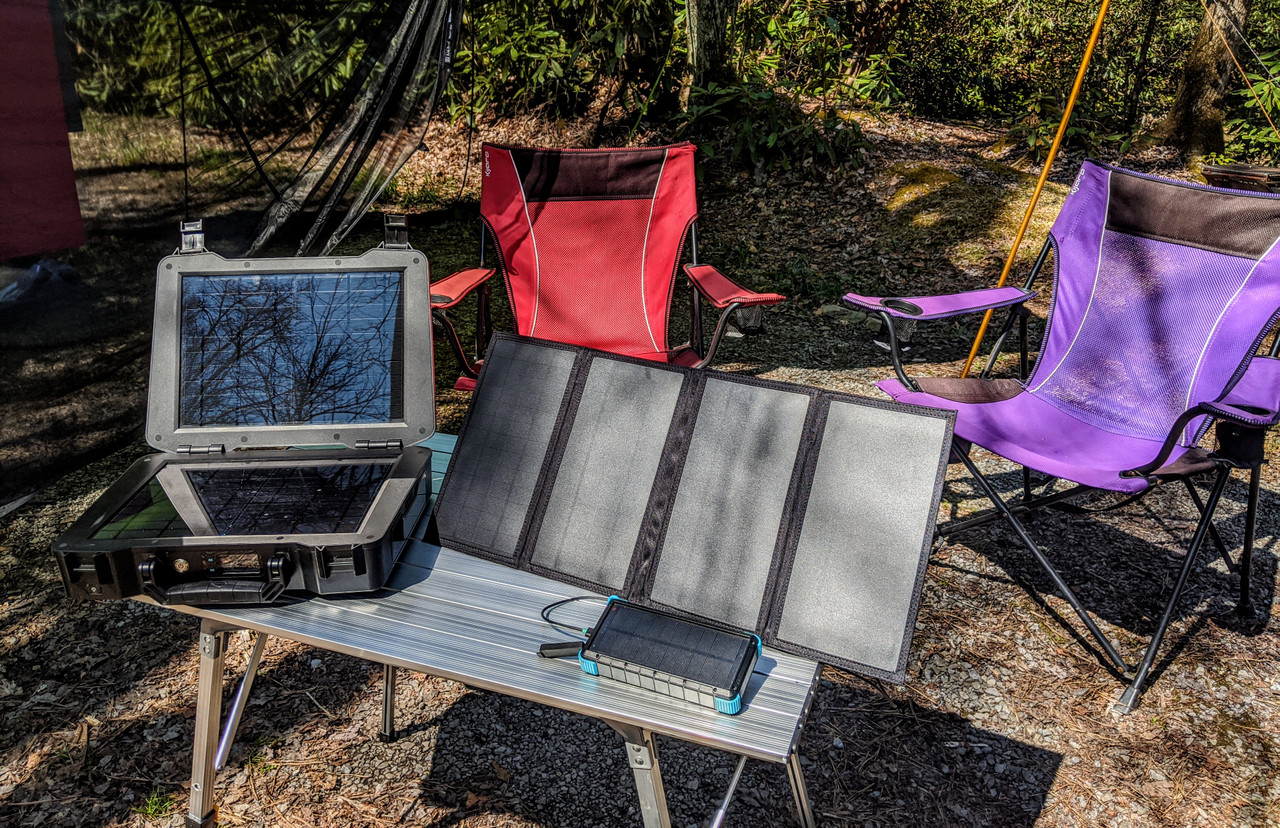How Solar Power Saved our Butts During this Pandemic!
During the past month, we’ve really put our solar powered system to the test in a situation that is far from optimal; we are “sheltering in place” in a southeastern national forest amid the Appalachian Mountains. Despite these factors, we have been able to generate enough electricity to power our camper as well as charge our laptops, smart phone, and even our back-up power by employing some a few solar tricks. We simply can’t believe how well our portable small solar powered system has responded to this challenge!
When the news of the severity of this health crisis hit on March 11, we were in the Blue Ridge Mountains of North Carolina. As part of our 2020 Road Show, we were just days away from doing some public presentations and open houses at both the local university and an outdoor outfitter. Like everyone else, many of our spring plans came to an abrupt halt. But, as digital nomads, we needed to continue to work without access to our usual public resources. We frequently work from coffeehouses or public libraries, and we typically plug-in while there. This is the first time in 7.5 years that those outlets aren’t an option (pun intended). We have needed to generate our own power with solar to keep working, and are actually writing this blog from our very own “Camp Quarantine,” located in the middle of a national forest about 2 miles away from any other campers, and about 10 miles from the closest town.

Like nearly 1 million other Americans, we don’t have a traditional home in which to stay put for a few weeks. But isolation away from others? We’ve got that one down! Even though we love visiting old friends and making new ones, being far away from crowds and big cities was part of the reason we hit the road in the first place. We live 24/7 out of our RV’s, vans, or travel trailers. Some of us never had a traditional home, others sold theirs like we did. Some folks are seeking a more sustainable way of life, some simply can’t afford a stick-built home, others are young families giving their children an educational experience of a lifetime, some work from the road or work seasonally in various parts of the country, and others are retired or partially-retired. We are a very diverse group of people, traveling our own way and for our own reasons; but, we all have one thing in common right now – we are all finding our own ways to social distance, stay healthy, and find an appropriate area to shelter in place without the comforts of a traditional home.

Across the country, travel has all but stopped and public campgrounds are completely closed – including national parks, state parks, national forest/BLM campgrounds, and even a good deal of BLM boondocking land out west have closed their doors to campers. Private campgrounds and RV parks are a mixed bag depending on the state – some have remained open to seasonal residents only, and others have closed their doors until the crisis is over. We simply didn’t want to risk being around others in a campground, or burden a friend with our extended presence and pressure on their resources.
As experienced boondockers, we chose a site near the headwaters of a creek, giving us plenty of water for showers, dishes, and even laundry. Through boiling or filtering water, we also have all the drinking water we need. With our privacy tent, pressurized solar shower, and bucket toilet, we have no hook-ups or holding tanks to worry about. We just employ Leave No Trace methods, and we are all set for as long as we need to be here.
We are lucky enough to be surrounded by trails to hike and cycle, and rivers to paddle – all with very few people. The only thing we don’t have at our campsite is a cell signal. This is fantastic as we prefer to be away from cell towers and powerlines, but it makes it difficult to stay informed during this crisis. Every few days, we either drive into town and sit outside the public library in our truck or hike up a local peak where we can get a decent signal. This isn’t the first time, and definitely won’t be the last, we’ve had to hike up mountains to get our news fix and upload some blogs and photos.

Solar Tricks We Use To Stay Fully Charged During Non-Optimal Conditions:
Use a Portable Panel – We use a Renogy 100W Folding Solar Suitcase which allows us the flexibility to move our panel around during the day to take advantage of the best sunlight available. We have an additional 20-foot extension cord allowing us a lot of flexibility to find the ideal location. This is particularly helpful in the summer when we want to leave the trailer in the shade and put the panel out in the sun.

Make Use of Extra Wattage – Typically our Lithium Iron Phosphate battery only takes a few hours of good sunshine to fully charge. During the middle of the day, if the sun is shining brightly and our Bluetooth app shows our house battery is already at 100%, we can take advantage of the extra wattage generated by the panel to charge other batteries, like our laptops, smartphone, back-up powerbanks, etc.

Keep an Eye on the Forecast – Just like we’re all trying to make food, toilet paper, and other resources go further, we try to plan for a stretch of rainy weather which might deplete our batteries. By charging up our Phoenix Power Station and E.Power bank, as well as conserving power in the trailer at night, we can make our power storage last longer. We have been surprised, though, that we get a decent trickle charge on even a relatively cloudy day.

Wherever in the world you are sheltering in place, we hope that you are staying healthy and safe and getting some quality time with loved ones! It will be soon enough that the world will be buzzing at a frenetic pace again. Try to enjoy it as much as you can, and maybe start dreaming about that off-grid cabin you want to build someday?

Learn more about Shari & Hutch’s solar powered adventures on their website and join them on the road via social media at Facebook, Instagram, and YouTube!










